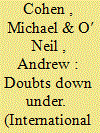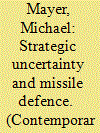| Srl | Item |
| 1 |
ID:
140025


|
|
|
|
|
| Summary/Abstract |
American extended deterrence commitments span the globe. Despite extensive research on the causes of deterrence successes and failures, evidence of which US allies find what extended deterrence commitments credible is elusive. This article utilizes interviews with former Australian policy-makers to analyze the credibility of the United States to defend Australian forces during the 1999 INTERFET intervention in East Timor. While there was no direct threat to Australian sovereignty, the episode stoked concerns in Canberra regarding the willingness of Washington to come to Australia's assistance. The Howard government coveted a US tripwire force presence, and the Clinton administration's unwillingness to provide this raised serious concerns among Australian political elites about the alliance. While this says little about the separate question of whether Washington would use nuclear or conventional weapons in defense of Australian sovereignty, the Timor case indicates the existence of an extended deterrence credibility deficit regarding the more probable low-intensity conflicts that Australia finds itself in.
|
|
|
|
|
|
|
|
|
|
|
|
|
|
|
|
| 2 |
ID:
142975


|
|
|
|
|
| Summary/Abstract |
Strategic uncertainty remains a significant challenge for defence planners and national leaders responsible for developing and acquiring future military capabilities. Concerns in the United States over missile proliferation during the 1990s were embodied in the 1999 National Intelligence Estimate (NIE), which predicted the emergence of a long-range ballistic missile threat by 2015. Comparing the NIEs predictions with the actual evolution of the threat reveals not only an overly pessimistic evaluation but also politicization of the intelligence assessment. At the time of its release, the report added to a growing sense of vulnerability and further encouraged policy-makers to make suboptimal missile defence acquisition decisions. In particular, the worst-case scenario thinking exemplified by the 1999 NIE contributed to an unnecessarily rushed testing programme, the premature deployment of homeland missile defence and an oversized system in Europe. Although missile defence may have strategic value, the rush to deploy has resulted in a costly and less effective military capability due to unfounded fears of strategic surprise and entrenched notions of the ballistic missile threat. Strategic uncertainty will always be a challenge, but focusing solely on developing capabilities with less regard to the actual threat environment is a recipe for costly and ineffective weapons systems.
|
|
|
|
|
|
|
|
|
|
|
|
|
|
|
|